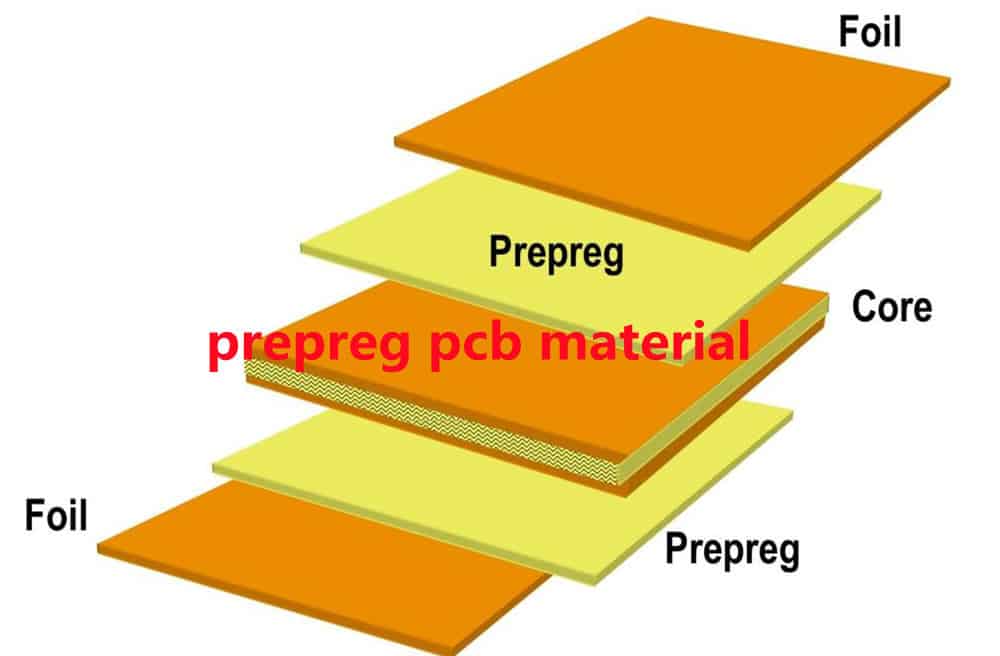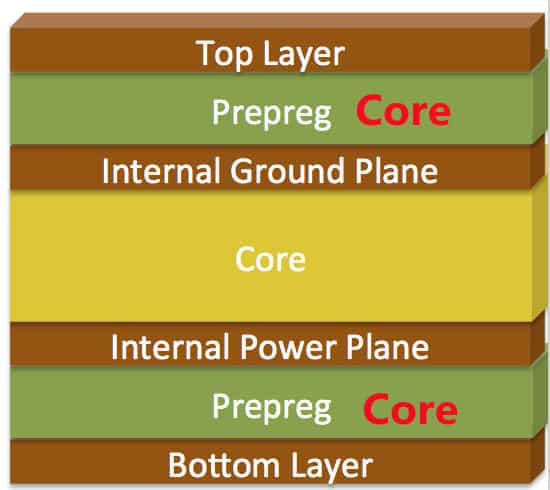Before you can have a deep understanding of what a prepreg is, you must understand what a printed circuit board (PCB) is. Printed circuit boards are seen in all electronics, as this is what makes them operate. It is composed of some electrical components that interconnect to a small device. In the absence of printed circuit boards, our electronics will fail to function as planned.
Prepreg PCB is mostly composed of many layers of copper layering, substrate, solder mask, small holes that are drilled in the device, multiple components, a coating (usually tin-lead) before they are fused together.
When it is explained this way, the process of developing a printed circuit board doesn’t look like something involving too much. Despite this, the process involved is extensive and you must have precise calculation to prevent malfunction. Now what are prepregs, how it relates in PCB manufacturing, and the difference between core and prepreg in PCB. Let’s find out.
Prepreg PCB: What is this?
Prepreg can be referred to as a part of F4 that is untreated. FR4 prepreg is usually used during the manufacturing process of printed circuit boards. Here it helps in the binding together of the etched prepreg cores. Also, it helps in gluing the etched fore to the copper foil.
Therefore, a prepreg can vary when it comes to the pcb prepreg thickness in line with the etched board’s height. When finding the difference between prepreg and core, core is known to be FR4 prepreg coated having copper on any of its sides and is usually manufactured in the prepreg core factory. The prepreg on the other hand is a kind of unused FR4, which gels itself to suit the PCB board’s structure.
What is the preparation process of the prepreg PCB? Normally, the prepreg PCB process involves the following.
- It helps in reinforcing using resins that can be thermoset or thermoplastic
- Removes excess resin
- Prepares for curing with the low and high temperature settings
Prepregs: How are they Made?
From its name, we can refer to it as a glass fiber cloth or weave having resin as a bonding agent impregnated with it. These glass fibers are then interwoven in order to create glass fabric. The weave is dried partially to create a kind of material known as B-stage material.
These prepregs are all B-stage materials. While manufacturing prepregs, there’s a need to follow the material’s grain direction since it permits the modification of the prepreg material according to requirements. The warp number and fill counts tell the quantity of resin that can be retained by the glass fabric.
What does Resin Flow in Prepreg Mean?
Anytime prepreg is heated under pressure, what you see is that the resin liquefies or melts and flows. This is referred to as resin flow. The rate and the pressure at which the heating up of the resin takes place affect the flow that takes place.
The time required at which the resin stays fluid enough to be able to flow with ease is limited, after which it gels. Here is the simple principle behind the process of lamination. The resin’s actual flow is important for the lamination process and it can be affected significantly by the conditions at which the lamination was done.
The actual flow amount available will affect some properties as well as the prepreg’s overall effectiveness to serve like a bonding sheet.
Measuring the Resin Content in Laminates and Prepreg
The resin content can be referred to as the ratio of the resin utilized in the prepreg to the total prepreg’s weight. This is the method used in testing the amount of resin present in the prepreg.
- Take a specimen or sample of prepreg and measure its initial weight
- Then dip this specimen in H2SO4 – sulphuric acid (LR grade) for some seconds to dissolve all the resin into the acid.
- Use water to rinse this specimen and then dry it
- Next, measure the specimen’s weight. The weight difference tells you the quantity of resin required for a specific quantity of your specimen.
Resin (in percentage) = the specimen’s loss of weight/ the specimen’s original weight x 100
The content of the resin will tell us about the thickness of a laminate piece when pressed. Also, the content has some effect on the properties like etching quality, drilling, coefficient of thermal expansion, and dielectric constant.
Prepreg vs Core: What’s the Difference between Prepreg and Core?

Here, we will discuss the difference between core and prepreg in PCB. Prepreg is very similar to core and that is why people usually get confused when trying to tell the difference between prepreg and core. Now, let me explain this to your easy understanding. The core can be referred to as the product of prepreg, as well as lamination. In contrast to prepreg, it is very rigid.
This prepreg core is composed of a type of laminate (fiberglass-epoxy) that meets the Flame retardant (FR4 prepreg) grade, and on either of its sides, has copper. Normally, prepreg core manufacturers manufacture cores. This is why the specified company takes responsibility for any faults present in the material, which may affect the smooth operation of the PCB.
Prepreg on the other hand, are composed of a similar prepreg pcb material to that of the prepreg core. However, they are dried partially without any lamination. They are also not as rigid as the core.
Also, an important difference between both when utilized in PCB stack up is in their dielectric constant (Dk). It is clear that after the lamination, the prepreg core’s Dk will not vary. However, after lamination, the Dk of the prepreg will vary. This is one good reason why some of the PCB applications in the military don’t utilize the foil method. Rather, they laminate using the core method.
Application of Prepreg in PCB Manufacturing
The usual application of prepregs during the manufacturing process of printed circuit boards has to do with the bonding of the copper parts of a laminate plated with copper and having copper foils applied in multi-layer rigid printed circuit boards.
Besides, this is also utilized in the manufacturing process of a rigid-flex or flexible circuit board. The application of prepreg in PCB manufacturing can be seen in multi-layered boards and complex PCBs.
Complex PCBs
If what you have is a complex PCB, then expect to have a prepreg that is more complex. You will have to utilize different prepreg types in order to get your desired PCB prepreg thickness and that of the board.
Complex Printed circuit boards are grouped into Rigid-Flex board and Flex Circuit having Stiffener PCB. For the flex circuit having stiffener PCB, the type of PCB layer achieved here is the single-sided PCB to the multi-layer PCB style. The application of the prepreg has to do with the FPC bonding, and in this case, using a stiffener.
For the rigid-flex type of board, its PCB layers range from double-sided to one with multiple layers. You can achieve this structure by making use of prepreg meant for bonding the CCL using copper foil as well as using a stiffener to bond the FPC.
Multi-layered Boards
A multi-layered board’s prepreg can be defined as what helps in holding the layers closely together. Once all the board’s layers are stacked, you can fuse them all together by ensuring the board is exposed to very high temperatures. The pcb prepreg thickness will work in line with the overall board’s thickness.
Also, the prepreg has to have some characteristics anytime it is utilized on a board having multiple layers. The surface of the cloth has to feel and look smooth. Also, it must be free of defects, cracks, foreign matter, stains, too much resin powder, or oil.
Application of Prepreg PCB: How is Prepreg PCB Used?

Advanced experts involved in fabricating make use of prepregs in reducing the weights of whatever part they may be preparing. Having these parts in low weight is needed in areas where the products or devices are meant to work against any resistance or flow.
Take for instance, aerospace requires lightweight parts; also, the same goes for sporting and racing materials. Pressure vehicles and some commercial products fare well when it comes to cost-efficiency whenever they have less weight. It becomes realistic to achieve something using prepreg. There’s a need for fabricators to be experienced in processes such as hand layup and vacuum bagging to help in using prepreg in and for their work.
Below are some primary industries that prepreg can be applied
- Infrastructure
- Construction
- Transportation
- Power/wind energy
- Marine
- Defense
Why is Prepreg Important?

There are various reasons why prepreg plays a vital role in the manufacturing of PCB. Let us consider them quickly.
The application and learning to work with prepregs is easy. You don’t require too much expertise to get accustomed or used to it. Using it regularly, even if you are someone that is less tech-savvy, you can get familiar with it. Therefore, the labor cost doesn’t increase sharply when you use prepregs.
The prepreg PCB material is less messy in contrast to the layups (wet style). Therefore, these contribute to the better management of waste during the process of manufacturing.
These come in different types like fiberglass, Kevlar, as well as hybrid. All you need is to name what it is intended for and there’ll always be a prepreg that suits it.
To crown it, there is a higher probability of reducing the device’s weight. This is important in equipment needed for working in some unique conditions.
Also, it is important to note that prepreg PCB material shows a much better shelf life anytime they are stored in temperatures that are colder. This is because the part composed of resin starts deactivated. This allows it to stay intact and cannot be used beyond a specified timeframe.
What Role does Prepreg Play?
You sure wish to know what role prepreg plays during the process of PCB development. It sure plays a significant role.
First, it provides a reliable gluing prepreg pcb material, which can bind or stick the PCB layers together. The purpose here is to secure the copper to the etched prepreg core, or fuse both etched cores.
Secondly, prepregs serve as a sheet that can function as an agent of insulation in a printed circuit board. Therefore, asides serving as a material for binding, prepreg also help in introducing insulation in the inner conducting areas of PCB boards with multi-layers.
Also prepreg PCB proves its usefulness and effectiveness in reducing the component’s weight. This means you can enjoy your equipment or device better as you use it minus the functionality hassles and cost of transportation.
What is Prepreg 7628, 2313, 2116, 1080, and 106?
Each prepreg’s name is derived from the fiberglass used. The prepreg 7628, 2313, 2116, 1080, 106 are types of glass fabric, with each of these numbers having different parameters that includes cured thickness, weight, resin content, etc.
Choosing Prepreg during PCB Design and Fabrication
Prepregs 7628, 2313, 2116, 1080, and 106 vary in resin content and thickness. Furthermore, there are different versions of high resin, medium resin, and standard resin. This depends on the amount of resin.
Choosing the best prepreg pcb material depends on your desired pcb prepreg thickness of the final PCB, the cost, dimensional stability, dielectric constant, and stack-up. The more the pcb prepreg thickness is, the higher the cost. For example, compared to 2116, expect 7628 to be higher. The cost involved in acquiring 2 sheets of 1080 will be more than that for 1 sheet of 2116.
Furthermore, just like the CCLs – copper clad laminates, prepregs also come in halogen-free and High-Tg types. However, you will not find it in every available pcb prepreg thickness. Note that if you have a customized layer buildup, always make sure you indicate the desired PCB prepreg thickness, and not just the names of the prepreg.
Conclusion
After reading this article, you should know what prepreg is all about and the difference between prepreg and core. Prepreg is a term that is abbreviated from the word pre-impregnated. Prepregs form a substrate and this is where the copper foils fuse in appropriately. Technically speaking we can refer to it as resin-impregnated fiberglass. Therefore, it functions in holding of the layers in order to achieve that thickness you desire for your PCB board. Also, it is responsible for binding the layers correctly, adding insulation between the layers, and reducing the general weight.

